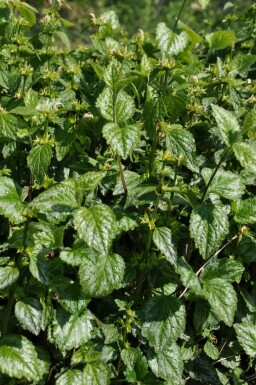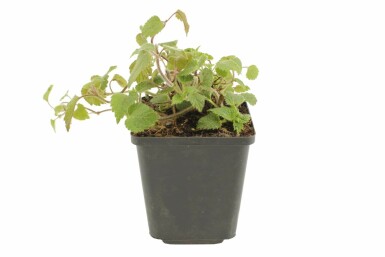

25cm




The Lamiastrum, commonly known as deadnettles, is a distinguished evergreen that brings an enduring verdancy to any garden. It boasts a striking foliage with a mosaic of green and white, creating a tapestry of color that remains vibrant throughout the year. While it does not bear fruit, the Lamiastrum graces us with delicate flowers in hues of yellow and white, adding a subtle yet enchanting touch to its overall appearance. This resilient plant, with its rich foliage and charming blossoms, is an excellent choice for gardeners seeking to infuse their space with continuous life and color.
The genus Lamiastrum, commonly known as deadnettles, is distinguished by its lush, variegated foliage and its ability to thrive across a vast array of settings. This robust, evergreen genus is ideal for gardeners seeking low-growing, ground-cover plants that offer year-round visual interest. Remarkably adaptable, Lamiastrum species are capable of flourishing in diverse soil conditions and can be situated in full sun, partial shade, or even in shaded locales.
Embrace the understated elegance that Lamiastrum brings to the garden, where its foliage creates a tapestry of silver and green. The 'Florentinum' variety, with its variegated leaves, adds a luminous quality to shaded areas, offering a serene backdrop or a charming groundcover that complements the more colorful denizens of your garden sanctuary.
We would like to provide some tips on how to plant and care for a Lamiastrum. By following these tips, you can be sure to enjoy your Lamiastrum for a long time.
For optimal growth, Lamiastrum thrives in a variety of lighting conditions, from full sun to partial shade and even in full shade. However, the variegation of the foliage may be more pronounced when the plant receives a bit of sunlight. It prospers in all soil types, provided that the soil is well-drained. Average water needs should be met to maintain its vibrant foliage and support its flowering months. This low-growing perennial is particularly suited for bordering garden beds or group plantings where its creeping, widespread growth habit can be appreciated without overwhelming neighboring plants.
For successful establishment, Lamiastrum should be planted in well-drained soil under a variety of light conditions, from full sun to shade. This versatile species thrives across a wide range of environments. When planting, ensure that the ground has been prepared with organic material to foster root development. The optimal time for planting is during cooler months, in spring or autumn, to reduce stress on the plant. Regular watering after planting will encourage a healthy root system, but be mindful to not overwater as this species requires only average moisture levels. For propagation, division in spring or autumn is ideal.
To maintain the vitality and enhance the variegated foliage of Lamiastrum, it is advisable to fertilize the plant in early spring. This early feeding will support the plant's energy needs during its flowering period and encourage lush, vibrant foliage throughout the growing season. A balanced, slow-release fertilizer is suitable for this species, ensuring a steady supply of nutrients as it enters its active growth phase.
Given its spreading growth habit, ensure that the fertilizer is evenly distributed across the soil where the roots spread, avoiding direct contact with the leaves to prevent burn. An additional application in mid-summer can help sustain the plant's vigor, especially if it's grown in a location with less than ideal soil conditions. Regular fertilization, alongside consistent watering, will keep Lamiastrum thriving and attractive.
Pruning of Lamiastrum should be carried out to maintain its attractive variegated foliage and control its creeping growth. After flowering in late June, trim the plant to encourage a dense habit and stimulate fresh foliage. Occasional thinning out of the stems throughout the growing season can also help in promoting good air circulation. It's important to remove any dead or yellowing leaves to keep the plant looking its best. Regular pruning will help contain its widespread growth and preserve the aesthetics of your border or edge planting.
Ensuring that Lamiastrum receives adequate moisture is crucial for its health and vigor. It thrives when the soil is kept evenly moist, particularly during the active growth period in the spring and early summer months. Although this plant has average water needs, attention should be given during prolonged dry spells to prevent stress. Regular watering will support the plant's creeping, widespread habit and the development of its vibrant foliage and flowers. It's beneficial to allow the soil to dry out slightly between waterings to encourage strong root development. Avoid overwatering, as well-drained soil is essential for the prevention of root rot.
Lamiastrum is admired for its resilience and ability to thrive in a variety of soil conditions. This versatile species can provide a lush underplanting in shaded areas where other plants might struggle. Its variegated foliage, often shimmering with silver hues, adds a bright touch to dim garden spots. Moreover, when it blooms, the contrast between the foliage and its delicate flowers offers a charming display that enhances the overall aesthetics of your garden space.
To ensure robust vitality and to stimulate new growth, division of Lamiastrum is a recommended practice. Ideally performed in the cooler months of spring or autumn, the process involves gently lifting the plant from the soil, teasing apart the root ball, and separating it into smaller sections. These sections should be replanted at the same depth they were growing previously, in well-drained soil. This method not only propagates your collection but also rejuvenates the parent plant, encouraging a lush, healthy spread of foliage and flowers in the following seasons.
Discover the charm of Lamiastrum, a delightful addition to any garden setting. This plant thrives with minimal fuss, offering a lush carpet of foliage that adds texture and contrast throughout the year. Its resilience and graceful appearance make Lamiastrum an impeccable choice for garden enthusiasts seeking both beauty and ease.
